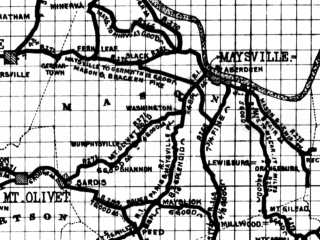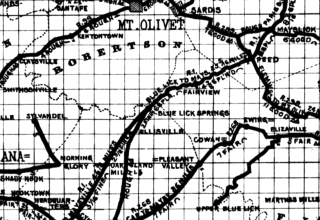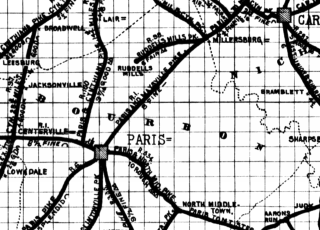


The famous Blue-Grass Region, while not entirely unknown to cyclists, deserves to be far more popular with them than it is. It is hard to imagine a country better adapted for the purposes of touring wheelmen. In beauty and variety of scenery, roads, and hospitality, it is unsurpassed.
 A small party of three, which did not make a crowd, consisting of a
friend, my wife and myself, disembarked at the Maysville landing on the
Ohio river at noon on a hot June day. After a good dinner, we started on
our ride, the first part of it being a mile-walk up the hill in rear of
the town. This was a hot climb, saved from being tedious by the grand
views of the river afforded at every turn of the road. From here, a most
excellent pike extends over and among the hills to Blue Licks,
twenty-four miles distant. It is a picturesque, rough and rugged
country, but so gradual are the up-grades that they are easy riding,
while coasting on the down-grades is safe and delightful.
A small party of three, which did not make a crowd, consisting of a
friend, my wife and myself, disembarked at the Maysville landing on the
Ohio river at noon on a hot June day. After a good dinner, we started on
our ride, the first part of it being a mile-walk up the hill in rear of
the town. This was a hot climb, saved from being tedious by the grand
views of the river afforded at every turn of the road. From here, a most
excellent pike extends over and among the hills to Blue Licks,
twenty-four miles distant. It is a picturesque, rough and rugged
country, but so gradual are the up-grades that they are easy riding,
while coasting on the down-grades is safe and delightful.
With a firm determination not to hurry, we rode in a leisurely, almost lazy manner. After a drink from a wayside well, and stretching at full length on the grass in the shade of a big tree, it was a pleasure to be alive free and in the open air. A heavy rain forced us to seek shelter. Down it came in sheets, showing no sign of abatement as the afternoon rapidly wore away. It finally cleared, however, and the excellence of the pike was shown by the fact that we were immediately able to ride without difficulty or discomfort.
 Approaching Blue Licks on a long downgrade, we passed through a cedar
forest. On our left and far below, a tributary of the Licking tumbled
its way over the rocks. We were on the dark and bloody ground. Here was
fought the celebrated battle, in which the whites were ambushed by the
Indians and almost annihilated. Another quarter-of-a-mile, and the
Licking was before us.
Approaching Blue Licks on a long downgrade, we passed through a cedar
forest. On our left and far below, a tributary of the Licking tumbled
its way over the rocks. We were on the dark and bloody ground. Here was
fought the celebrated battle, in which the whites were ambushed by the
Indians and almost annihilated. Another quarter-of-a-mile, and the
Licking was before us.
There is no town at Blue Licks. In antebellum days it was a famous watering-place, the "Saratoga of the South." The only remaining hotel is a ramshackle, old affair, verging in appearance on a picturesque ruin. It would hardly do for winter quarters, but furnishes good summer accommodations and first-rate meals. The lady of the party was charmed with the quiet beauty of the place, and we remained the next day, exploring the battle-field, boating up the Licking, and filling up on the mineral waters and stories of Daniel Boone.
 Leaving Blue Licks, we continued on through the cedars. The scenery was
much the same as that which preceded it, — always beautiful, never
monotonous. A hard, smooth road, with plenty of shade and many winds,
brings us to Paris. Now we are entering the Blue-Grass Region. The rugged
hills slide into a pretty, undulating, prosperous looking country.
Comfortable old-fashioned houses, covering a large area, are far back
from the road, with a park-like expanse in front. A cheery, kind-hearted
people have a nod and a pleasant word for the passing stranger. Every
indication is that of a section where people live well and do not work
hard. With special interest, we noted that at every cross-roads post-office,
there was a knot of saddle-horses. Horses had been seen on other
trips, but they were almost invariably harnessed to some sort of
vehicle. Occasionally, a half-grown boy, with awkward seat on a
plow-horse, had been seen going after the cows. Here horseback-riding
seemed a general method of locomotion. Good riders, men and women, were
mounted on genuine saddle-horses.
Leaving Blue Licks, we continued on through the cedars. The scenery was
much the same as that which preceded it, — always beautiful, never
monotonous. A hard, smooth road, with plenty of shade and many winds,
brings us to Paris. Now we are entering the Blue-Grass Region. The rugged
hills slide into a pretty, undulating, prosperous looking country.
Comfortable old-fashioned houses, covering a large area, are far back
from the road, with a park-like expanse in front. A cheery, kind-hearted
people have a nod and a pleasant word for the passing stranger. Every
indication is that of a section where people live well and do not work
hard. With special interest, we noted that at every cross-roads post-office,
there was a knot of saddle-horses. Horses had been seen on other
trips, but they were almost invariably harnessed to some sort of
vehicle. Occasionally, a half-grown boy, with awkward seat on a
plow-horse, had been seen going after the cows. Here horseback-riding
seemed a general method of locomotion. Good riders, men and women, were
mounted on genuine saddle-horses.